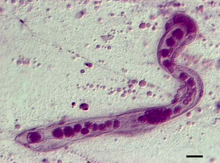Dicyemida
| Dicyemida | |
|---|---|

| |
| Photomicrograph of Dicyema japonicum | |
| Scientific classification | |
| Domain: | Eukaryota |
| Kingdom: | Animalia |
| Subkingdom: | Eumetazoa |
| Clade: | ParaHoxozoa |
| Clade: | Bilateria |
| Clade: | Nephrozoa |
| (unranked): | Protostomia |
| (unranked): | Spiralia |
| Clade: | Platytrochozoa |
| (unranked): | Mesozoa |
| Phylum: | Dicyemida |
| Class: | Rhombozoa |
Dicyemida, also known as Rhombozoa, is a phylum of tiny
Taxonomy

Classification is controversial.[1] Traditionally, dicyemids have been grouped with the Orthonectida in the phylum Mesozoa and, from 2017, molecular evidence[2][3] appears to confirm this.
However, other molecular phylogenies have placed the dicyemids more closely related to the
The phylum (or
Anatomy
Adult dicyemids range in length from 0.5 to 7 millimetres (0.020 to 0.276 in), and they can be easily viewed through a light microscope.[10] They display eutely, a condition in which each adult individual of a given species has the same number of cells, making cell number a useful identifying character. Dicyemida lack respiratory, circulatory, excretory, digestive, and nervous systems.
The organism's structure is simple: a single axial cell is surrounded by a jacket of twenty to thirty
Life cycle
Dicyemids exist in both asexual and sexual forms. The former predominate in juvenile and immature hosts, and the latter in mature hosts. The asexual stage is termed a nematogen; it produces vermiform larvae within the axial cell. These mature through direct development to form more nematogens.[10] Nematogens proliferate in young cephalopods, filling the kidneys.
As the infection ages, perhaps as the nematogens reach a certain density, vermiform larvae mature to form rhombogens, the sexual life stage, rather than more nematogens. This sort of density-responsive reproductive cycle is reminiscent of the asexual reproduction of sporocysts or rediae in larval
Rhombogens contain hermaphroditic gonads developed within the axial cell. These gonads, more correctly termed infusorigens, self-fertilise to produce infusoriform larvae. These larvae possess a very distinctive morphology, swimming about with ciliated rings that resemble headlights. It has long been assumed that this sexually produced infusoriform, which is released when the host eliminates urine from the kidneys, is both the dispersal and the infectious stage. The mechanism of infection, however, remains unknown, as are the effects, if any, of dicyemids on their hosts.[10]
Some part of the dicyemid life cycle may be tied to
References
- PMID 17961212.
- PMID 28560048.
- ^ PMID 35858055.
- ^ PMID 8865666.
- S2CID 6070504.
- S2CID 25877334.
- ^ "Kantharellidae". Integrated Taxonomic Information System. Retrieved 5 April 2010.
- ^ "Rhombozoa". Integrated Taxonomic Information System. Retrieved 30 January 2024.
- ^ "Heterocyemida". Integrated Taxonomic Information System. Retrieved 30 January 2024.
- ^ ISBN 0-03-056747-5.
- ^ Furuya, Hidetaka [in Japanese] (2010). "Systematics, morphology, and life cycle of dicyemid mesozoans (中生動物ニハイチュウの分類、系統、生活史)". Jpn. J. Vet. Parasitol. 9 (1): 128–134.
- ^ Hochberg, F.G. (1990). "Diseases caused by protistans and mesozoans".
{{cite journal}}: Cite journal requires|journal=(help) in Kinne, Otto. Diseases of Marine animals. Vol. 3. Hamburg: Biologische Anstalt Helgoland. pp. 47–202.
Further reading
![]() Data related to Rhombozoa at Wikispecies
Data related to Rhombozoa at Wikispecies
- Furuya H, Tsuneki K (May 2003). "Biology of dicyemid mesozoans". Zool. Sci. 20 (5): 519–32. S2CID 29839345.
- Furuya, H.; Hochberg, F. G.; Tsuneki, K. (2003). "Reproductive traits in dicyemids". Marine Biology. 142 (4): 693–706. S2CID 82265820.
- Hochberg, F.G. (1982). "The "kidneys" of cephalopods: a unique habitat for parasites". Malacologia. 23: 121–134.
- McConnaughey, B.H. (1951). "The life cycle of the dicyemid Mesozoa". University of California Publications in Zoology. 55: 295–336.
- Pawlowski J, Montoya-Burgos JI, Fahrni JF, Wüest J, Zaninetti L (October 1996). "Origin of the Mesozoa inferred from 18S rRNA gene sequences". Mol. Biol. Evol. 13 (8): 1128–32. PMID 8865666.
